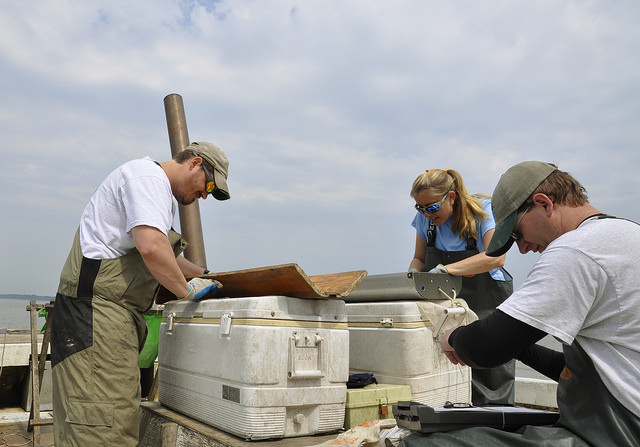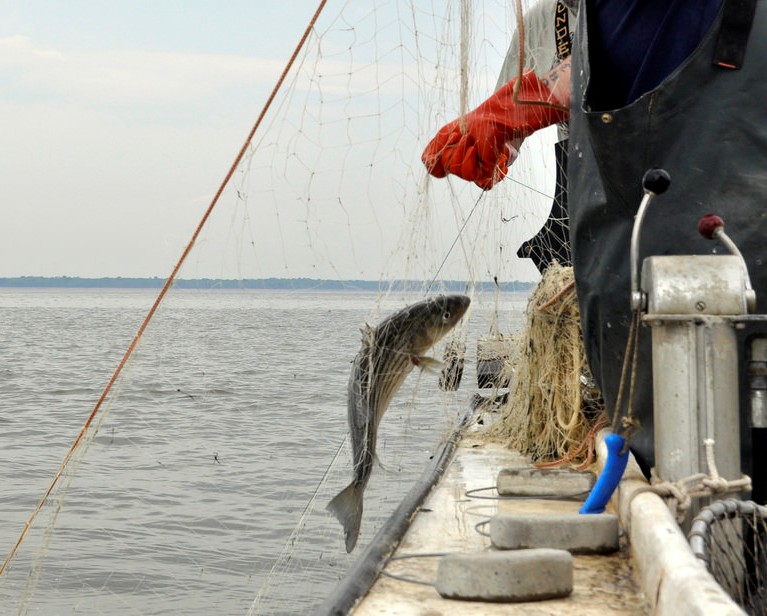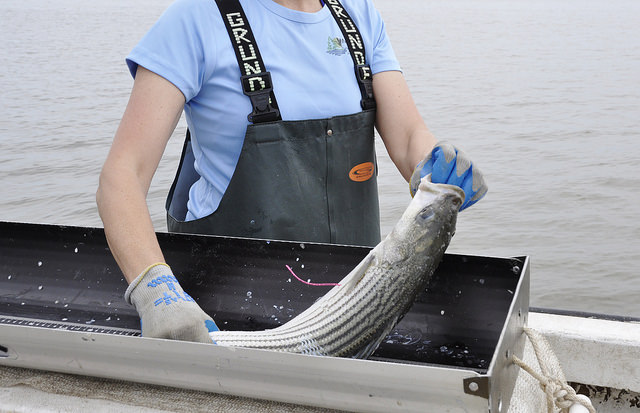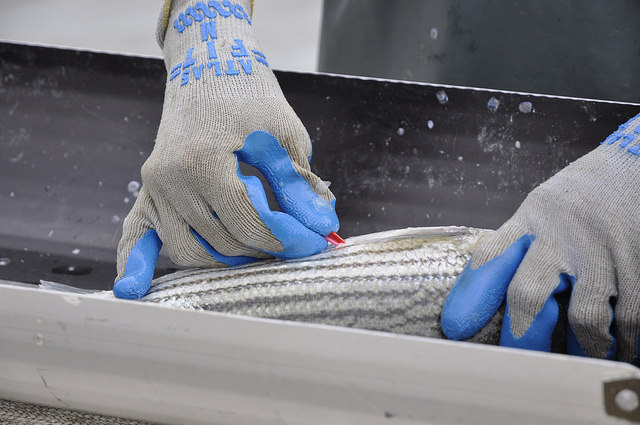Striped Bass Spring Spawning Stock Assessment

The Striped Bass Program is responsible for monitoring and characterizing Maryland's portion of the Chesapeake Bay's spawning stock of striped bass. Since 1985, biologists at the Maryland Department of Natural Resources have been conducting the spawning stock survey in
historic spawning locations on the Upper Chesapeake Bay and the Potomac River. In concurrence with monitoring the spawning stock, the department is part of the
Cooperative Coastal Striped Bass Tagging Program. This program tags spawning striped bass with United States Fish and Wildlife Service internal anchor tags to evaluate stock dynamics of the migratory Atlantic Coast striped bass. All the results from these surveys are reported to the United States Fish and Wildlife Service in the annual Federal Aid Report and to the Atlantic States Marine Fisheries Commission in the annual Compliance Report.
Spawning Stock Survey

The goal of this survey is to characterize the age, size, and sex structure, and abundance at age of spawning striped bass in Maryland's portion of the Chesapeake Bay. The survey is conducted up to six days a week from late March to mid May. Striped bass are sampled using experimental drift gill nets in the Upper Chesapeake Bay and Potomac River. The experimental drift gill nets are a series of different mesh size, nylon multifilament panels (3, 3.75, 4.5, 5.25, 6, 6.5, 7, 8, 9, and 10 inch stretch-mesh). Each panel is approximately 150 feet long and 10 feet deep, with about 10 feet in-between each net. Drift nets are deployed for short periods of time during and near slack tide, twice a day at one random site each, in the Upper Chesapeake Bay and Potomac River. Biologists collect length, fish health, sex, maturity stage and scale samples to determine age. Scale samples are used to make an age-length key for the spawning stock. This key is used to determine the size at age and sex ratio at age of the striped bass spawning stock of Maryland's portion of the Chesapeake Bay. These data are inputs to the coastwide stock assessment conducted by the Atlantic States Marine Fisheries Commission.
 Along with biological data, healthy striped bass are tagged with internal anchor tags provided by the United States Fish and Wildlife Service (USFWS). A preliminary total of 1,540 (468 in the Upper Chesapeake Bay and 1,072 on the Potomac River) striped bass were sampled during the 2023 spring spawning stock survey. Of the 468 striped bass in the Upper Chesapeake Bay, there were 32 females and 436 males. In the Potomac River, there were 33 females and 1,039 males sampled. These numbers are preliminary total fish caught and are not standardized for catch per unit of effort until later reports.
Along with biological data, healthy striped bass are tagged with internal anchor tags provided by the United States Fish and Wildlife Service (USFWS). A preliminary total of 1,540 (468 in the Upper Chesapeake Bay and 1,072 on the Potomac River) striped bass were sampled during the 2023 spring spawning stock survey. Of the 468 striped bass in the Upper Chesapeake Bay, there were 32 females and 436 males. In the Potomac River, there were 33 females and 1,039 males sampled. These numbers are preliminary total fish caught and are not standardized for catch per unit of effort until later reports.
Upper Bay Gill Net Survey
The graph below shows the results of the Upper Bay Gill Net Survey from 1985 until 2023.
Potomac River Gill Net Survey
The graph below shows the results of the Potomac River Gill Net Survey from 1985 until 2023.
Striped Bass Tagging Study

The purpose of this survey is to evaluate Chesapeake Bay resident and Atlantic migratory striped bass stock dynamics. This study is conducted by Maryland Department of Natural Resources biologists during the spring spawning stock survey as part of the Cooperative Coastal Striped Bass Tagging Program, and the results are part of the coastwide stock assessment conducted by Atlantic States Marine Fisheries Commission. Biologists apply pink internal anchor tags through an incision made in the left side of healthy fish, slightly behind and below the tip of the pectoral fin. Tagging striped bass allows biologists to collect data on individual striped bass over time (growth rates, mortality rates, survival rates, and migration rates/patterns). In 2023, MD DNR biologists tagged a total of 669 striped bass (269 in the Upper Chesapeake Bay and 400 on the Potomac River). To date, over 40,000 striped bass have been tagged on the spawning grounds in Maryland, and over 9,000 recaptures have been reported. The success of the tagging program relies on anglers reporting their tags. To report a tagged fish please go to the department's
Tag Return Program or call the United States Fish and Wildlife Service at 1-800-448-8322.
Tags Deployed
The graph below shows the amount of the striped bass tags in the Upper Bay and Potomac River from 1987 until 2023.
Invasive Blue Catfish
During the spawning stock survey multiple fish species are sampled along with striped bass to help assess the health of the bay. One fish species of concern is the blue catfish which is invasive to Maryland waters. Introduced in the 1970's for recreational fishing, blue catfish were first sampled in the Potomac River in 1996 (n = 3) and in the Upper Bay in 2005 (n = 2). In 2023, a total of 143 blue catfish were encountered on the Upper Bay spawning grounds (total of 624 since 2005), more than the number seen between 2005 and 2021 (149 fish). Since sampling 3 total fish in 1996, a total of 19,660 blue catfish have been sampled on the Potomac River. Blue catfish are a cause for concern given their aggressive feeding habits, growing to large sizes (>100 pounds) and lack of natural predators. For these reasons they have the capability to outcompete native fish species. The Maryland Department of Natural Resources asks anglers to remove and kill any blue catfish they catch. For more information on blue catfish go to the department's
Invasive Species page.
Spawning Area Catch Rates
The graph below shows the amount catches striped bass and blue catfish in the Upper Bay and Potomac River from 1996 until 2023.
